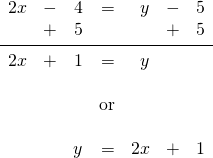Chapter 3: Graphing
3.5 Constructing Linear Equations
Quite often, students are required to find the equation of a line given only a data point and a slope or two data points. The simpler of these problems is to find the equation when given a slope and a data point. To do this, use the equation that defines the slope of a line:
![]()
This becomes:
![]()
To illustrate this method, consider the following example.
Example 3.5.1
Find the equation that has slope ![]() and passes through the point
and passes through the point ![]() .
.
First, replace ![]() with 2 and
with 2 and ![]() with
with ![]() .
.
![]()
Next, reduce the resulting equation.
First, multiply both sides by the denominator to eliminate the fraction:
![]()
This leaves:
![]()
Which simplifies to:
![]()
This can be written in the ![]() -intercept form by isolating the variable
-intercept form by isolating the variable ![]() :
:

It is also useful to write the equation in the general form of ![]() , where
, where ![]() ,
, ![]() , and
, and ![]() are integers and
are integers and ![]() is positive.
is positive.
In general form, ![]() becomes:
becomes:

The standard form of a linear equation is written as ![]() .
.
In standard form, ![]() becomes:
becomes:

The three common forms that a linear equation can be written in are:
![Rendered by QuickLaTeX.com \[\begin{array}{rl} \text{Slope-intercept form:}& y = mx + b \\ \\ \text{General form:}&Ax + By + C = 0 \\ \\ \text{Standard form:}&Ax + By = C \end{array}\]](https://pressbooks.bccampus.ca/intermediatealgebrakpu/wp-content/ql-cache/quicklatex.com-adc9acd672c8c100a163adc57e4dfff4_l3.png)
Example 3.5.2
Find the equation having slope ![]() that passes though the point
that passes though the point ![]()
Write the solutions in slope-intercept form and in both general and standard forms.
First, replace ![]() with
with ![]() and
and ![]() with
with ![]()
![]()
Multiplying both sides by ![]() to eliminate the denominators yields:
to eliminate the denominators yields:
![]()
Which simplifies to:
![]()
Writing this solution in all three forms looks like:
![Rendered by QuickLaTeX.com \[\begin{array}{rl} \text{Slope-intercept form:}&y=-\dfrac{1}{2}x-7 \\ \\ \text{General form:}&x+2y+7=0 \\ \\ \text{Standard form:}&x+2y=-7 \end{array}\]](https://pressbooks.bccampus.ca/intermediatealgebrakpu/wp-content/ql-cache/quicklatex.com-99b701b1cb81ca518c7558462ed45a34_l3.png)
The more difficult variant of this type of problem is that in which the equation of a line that connects two data points must be found. However, this is simpler than it may seem.
The first step is to find the slope of the line that would connect those two points. Use the slope equation, as has been done previously in this textbook. After this is done, use this slope and one of the two data points given at the beginning of the problem. The following example illustrates this.
Example 3.5.3
Find the equation of the line that runs through ![]() and
and ![]() .
.
First, find the slope:
![Rendered by QuickLaTeX.com \[\begin{array}{rrl} m&=&\dfrac{y_2-y_1}{x_2-x_1} \\ \\ m&=&\dfrac{8--2}{3--1} \text{ or } \dfrac{8+2}{3+1} \\ \\ m&=&\dfrac{10}{4} \text{ or } \dfrac{5}{2} \end{array}\]](https://pressbooks.bccampus.ca/intermediatealgebrakpu/wp-content/ql-cache/quicklatex.com-25bbafe6a7e6ee33fa2197bc37dd5907_l3.png)
Now, treat this as a problem of finding a line with a given slope ![]() running through a point
running through a point ![]() .
.
The slope is ![]() , and there are two points to choose from:
, and there are two points to choose from: ![]() and
and ![]() . Choose the simplest point to work with. For this problem, either point works. For this example, choose
. Choose the simplest point to work with. For this problem, either point works. For this example, choose ![]() .
.
![Rendered by QuickLaTeX.com \[\begin{array}{rrl} m&=&\dfrac{y-y_1}{x-x_1} \\ \\ \dfrac{5}{2}&=&\dfrac{y-8}{x-3} \end{array}\]](https://pressbooks.bccampus.ca/intermediatealgebrakpu/wp-content/ql-cache/quicklatex.com-b276c36cdc76bcab8fe21bba1cc728ee_l3.png)
Eliminate the fraction by multiplying both sides by ![]() .
.
This leaves ![]() which must be simplified:
which must be simplified:
![Rendered by QuickLaTeX.com \[\begin{array}{rrrrrrr} 5(x&-&3)&=&2(y&-&8) \\ 5x&-&15&=&2y&-&16 \\ -2y&+&15&&-2y&+&15 \\ \midrule 5x&-&2y&=&-1&& \end{array}\]](https://pressbooks.bccampus.ca/intermediatealgebrakpu/wp-content/ql-cache/quicklatex.com-93f75ac2252128b3fb2878f726d8b452_l3.png)
This answer is in standard form, but it can easily be converted to the ![]() -intercept form or general form if desired.
-intercept form or general form if desired.
Questions
For questions 1 to 12, write the slope-intercept form of each linear equation using the given point and slope.
 and
and 
 and
and 
 and
and 
 and
and 
 and
and 
 and
and 
 and
and 
 and
and 
 and
and 
 and
and 
 and
and 
 and
and 
For questions 13 to 24, write the general form of each linear equation using the given point and slope.
 and
and 
 and
and 
 and
and 
 and
and 
 and
and 
 and
and 
 and
and 
 and
and 
 and
and 
 and
and 
 and
and 
 and
and 
For questions 25 and 32, write the slope-intercept form of each linear equation using the given points.
 and
and 
 and
and 
 and
and 
 and
and 
 and
and 
 and
and 
 and
and 
 and
and 
For questions 33 to 40, write the general form of each linear equation using the given points.
 and
and 
 and
and 
 and
and 
 and
and 
 and
and 
 and
and 
 and
and 
 and
and 

